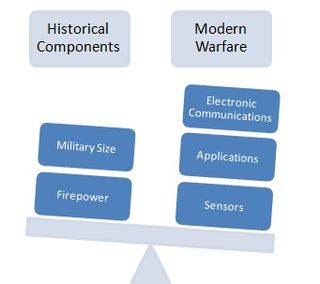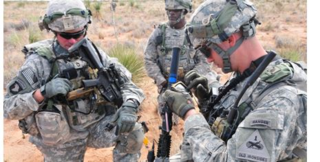Enterprise Mobility & the Connected Worker Blog
Warfare in the Age of Information and Mobility
In an upcoming military and defense report, VDC will examine the unique security, application, and hardware requirements for mobile devices employed among military users.
The phrase “fog of war” describes the general state of uncertainty surrounding military operations, and has been referenced frequently in military literature for over a century. Equipped with less than perfect information, military leaders use their best judgment and the little information they have to make decisions in the theatre of war. Generally, these gaps in knowledge, or situational awareness, occur on both sides of the battlefield, essentially offsetting one another. However, if one side does possess superior information, even in the slightest, then it could tip the scales of war. This logic largely supports the network-centric warfare doctrine, which argues that communication, computer, and IoT systems provide an operational and strategic advantage in war. More generally, a military receives a competitive advantage when they have the ability to collect, analyze, communicate, and act on information in a synchronized manner.
 Abiding by the principles of network-centric warfare, militaries have researched, developed, and implemented a growing arsenal of information and communications technologies. The United States, the largest military spender, maintains a diminishing global lead in technological superiority. This lead is largely owed to astronomical spending and access to some of the most cutting-edge technology coming out of Silicon Valley and other high-tech geographical clusters located within the nation. Private sector companies have played, and will continue to play, an important role in developing products for command, control, communications, computers, and intelligence (C4I) solutions. Procurement of commercial off-the-shelf-technology (COTS) has increased over the past decade owing largely to the private sector’s improved technical competency and the decrease of Western military budgets. Notably, this reduction in the West contrasts increased military expenditures in the Asia Pacific and Middle East regions.
Abiding by the principles of network-centric warfare, militaries have researched, developed, and implemented a growing arsenal of information and communications technologies. The United States, the largest military spender, maintains a diminishing global lead in technological superiority. This lead is largely owed to astronomical spending and access to some of the most cutting-edge technology coming out of Silicon Valley and other high-tech geographical clusters located within the nation. Private sector companies have played, and will continue to play, an important role in developing products for command, control, communications, computers, and intelligence (C4I) solutions. Procurement of commercial off-the-shelf-technology (COTS) has increased over the past decade owing largely to the private sector’s improved technical competency and the decrease of Western military budgets. Notably, this reduction in the West contrasts increased military expenditures in the Asia Pacific and Middle East regions.
The investments in C4I technology include hardware, software, and networks; the three components interact with one another to produce insights and an operating picture necessary for informed decision-making. Crucial to ensuring this integration and interaction are mobile devices and applications, which provide soldiers and support-employees with the tools to distribute and act on information. In the most basic sense, these devices act as receptacles for mobile applications that serve as the gateway to data often stored behind organization firewalls. Tablets and smartphones now possess powerful computing capabilities in a mobile format, thus ensuring access to information anywhere and at anytime (assuming an available network is present). This value proposition has encouraged defense organizations to implement mobile devices in the field as well as in-and-outside the office. Imposed requirements such as general-use guidelines and enhanced security features including device management software and encryption help to reduce risks associated with mobility and are representative of a “secure enough” approach taken by many military organizations. This is the most feasible approach since completely impenetrable mobile devices are the stuff of science-fiction. The measures employed as part of this approach increase security while maintaining functionality, and most agree that the gains of greater information distribution offset minimized security risks.
The Department of Defense’s mobile policy abides by these guidelines and includes an application store, which grants employees access to productivity enhancing, commercially available applications as well as line of business applications that enable business processes and access to organization data. Security measures differ based on whether an employee resides on the classified or unclassified network, but in general, the DoD acknowledges the trade-off between security and usability and has increased the footprint of devices under management to include popular consumer devices such as iPhones and Samsung Galaxy smartphones. While this type of enterprise-use is fairly common throughout the private-sector albeit with greater security measures, the field use-cases for mobile devices are certainly unique.
 The U.S. Army’s Nett Warrior system uses consumer-grade Android smartphones to arm individual soldiers with enhanced situational awareness and communication capabilities on the battlefield. This use-case falls directly in line with the network-centric warfare doctrine since it facilitates informed decision-making in an arena in which judgments must be made quickly and frequently involve life and death decisions. Operating on radio networks, these devices provide details on friendly as well as enemy troop locations, and allow soldiers to send text communications to one another. Perhaps most importantly, this system serves as a platform on which more applications can be built; increasing the capabilities of soldiers and improving their effectiveness in the field while reducing risks associated with uninformed decision-making. As tactical radio networks evolve and mobile device technology becomes more powerful, soldiers will essentially have access mini computers in the field. Therefore, this device will not only improve communications with command and control and among soldiers, but will also serve as an interface for data garnered from numerous sensors on the battlefield and satellites in the sky.
The U.S. Army’s Nett Warrior system uses consumer-grade Android smartphones to arm individual soldiers with enhanced situational awareness and communication capabilities on the battlefield. This use-case falls directly in line with the network-centric warfare doctrine since it facilitates informed decision-making in an arena in which judgments must be made quickly and frequently involve life and death decisions. Operating on radio networks, these devices provide details on friendly as well as enemy troop locations, and allow soldiers to send text communications to one another. Perhaps most importantly, this system serves as a platform on which more applications can be built; increasing the capabilities of soldiers and improving their effectiveness in the field while reducing risks associated with uninformed decision-making. As tactical radio networks evolve and mobile device technology becomes more powerful, soldiers will essentially have access mini computers in the field. Therefore, this device will not only improve communications with command and control and among soldiers, but will also serve as an interface for data garnered from numerous sensors on the battlefield and satellites in the sky.
Militaries face a number of obstacles—budgets, fragmentation, and legacy technologies—that inhibit their use of modern technologies. Nonetheless, these organizations have made great strides in incorporating mobility within the past few years alone. The idea of equipping individual soldiers with consumer-grade mobile devices in the field for communications and situational awareness would have seemed ludicrous to many only a few years ago; yet Nett Warrior now embodies these ideas. VDC expects “lowest price technologically acceptable” acquisitions to increase the competitiveness of commercial vendors and even consumer-grade products in some instances. Only time will tell whether these devices are suitable for military use-cases as insights into failure rates in mission-critical environments are currently unavailable. While policies and requirements for mobile devices will undoubtedly change to reflect evolving technologies and use-cases, the increasing role of mobile devices in this space is inevitable. Military leaders view information as a transformative tool on and off the battlefield, and mobility is a crucial component for transmitting and accessing this resource.
View the 2017 Enterprise Mobility & Connected Devices Research Outline to learn more.